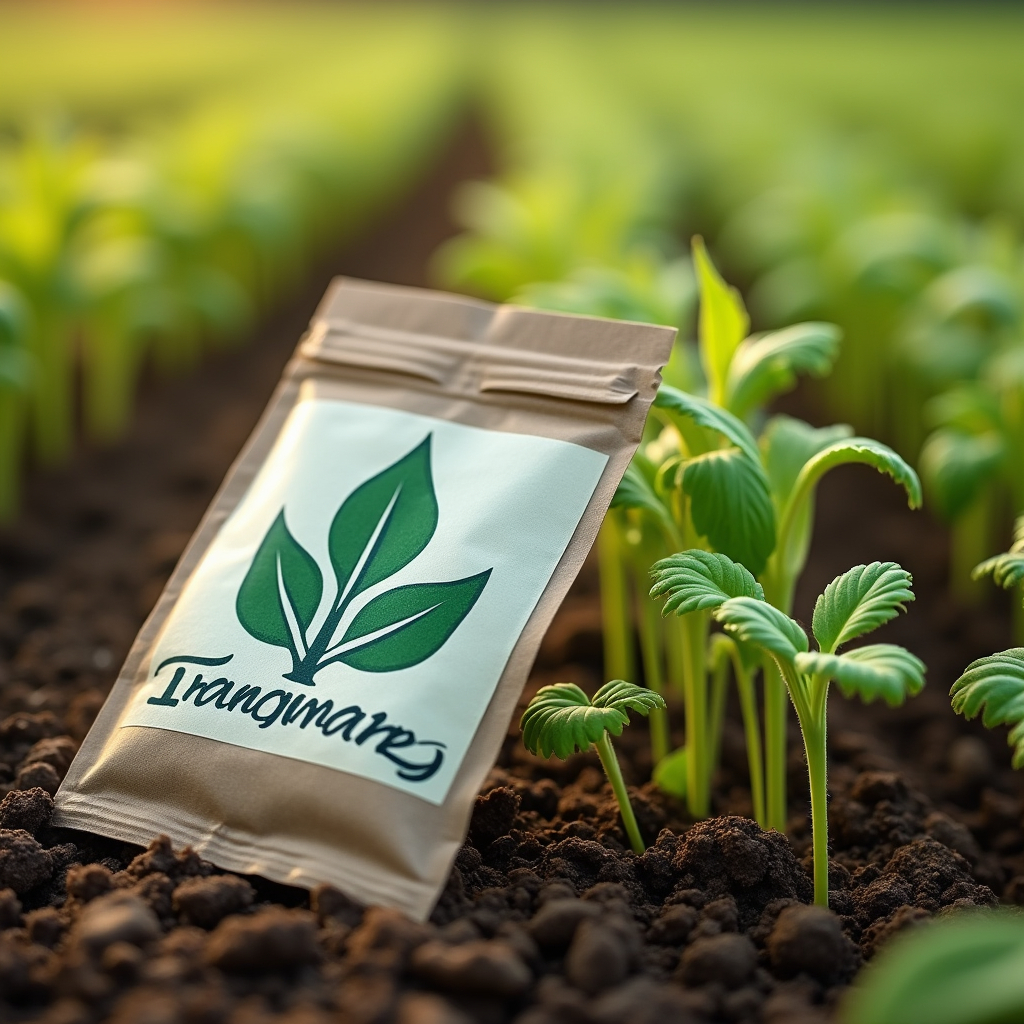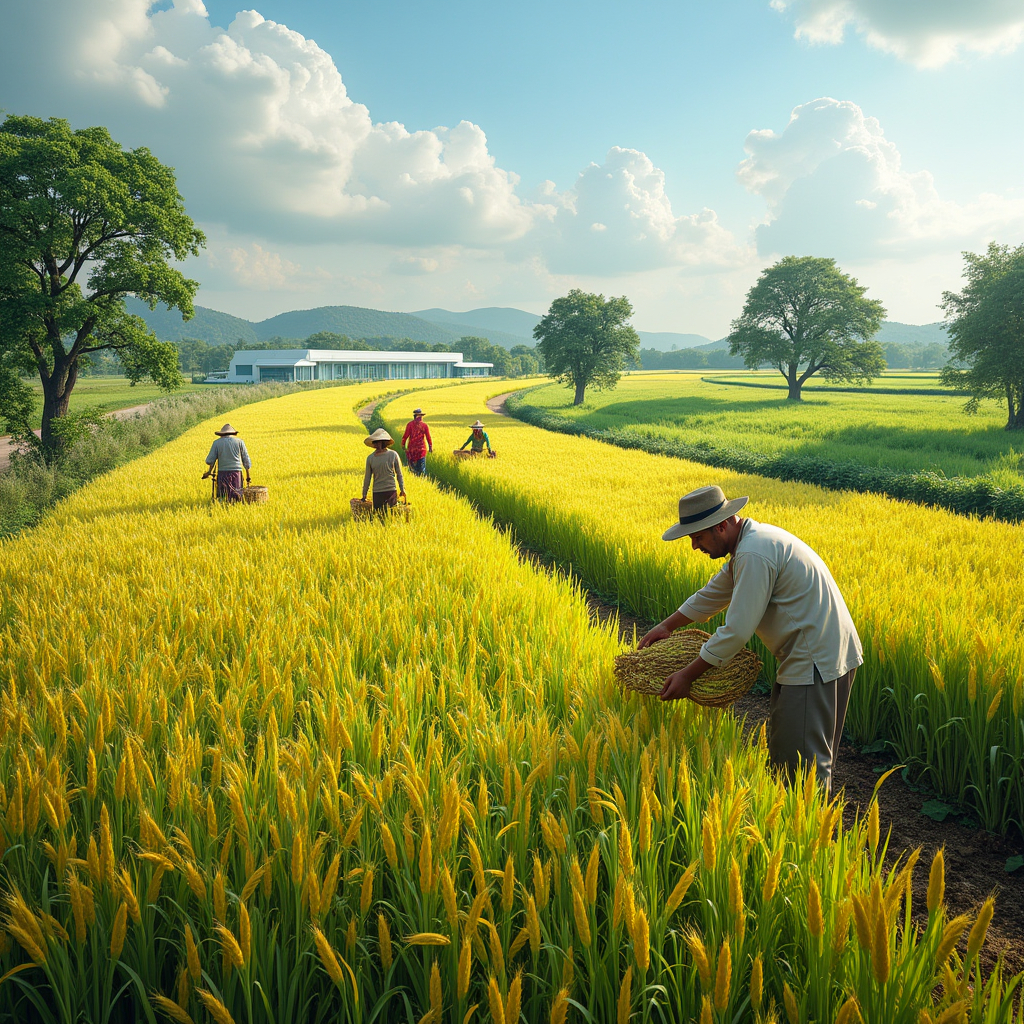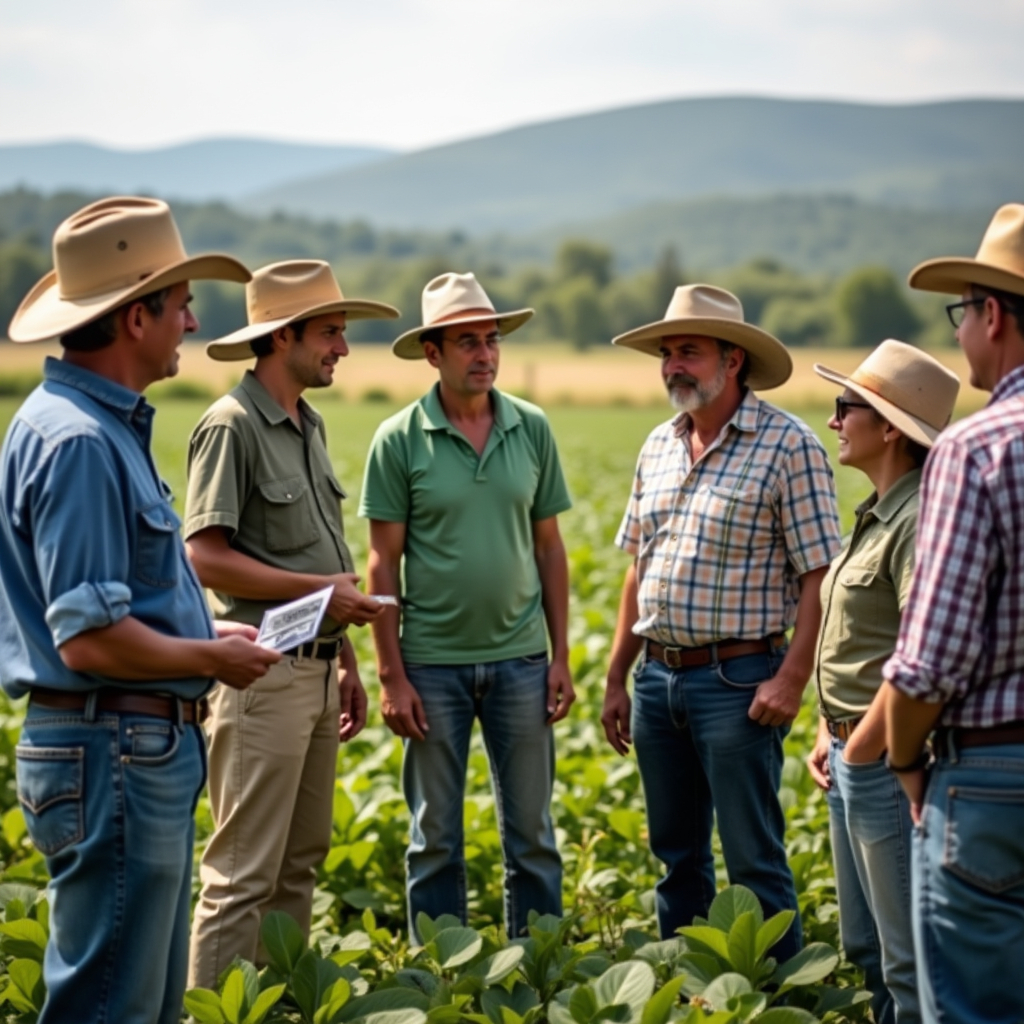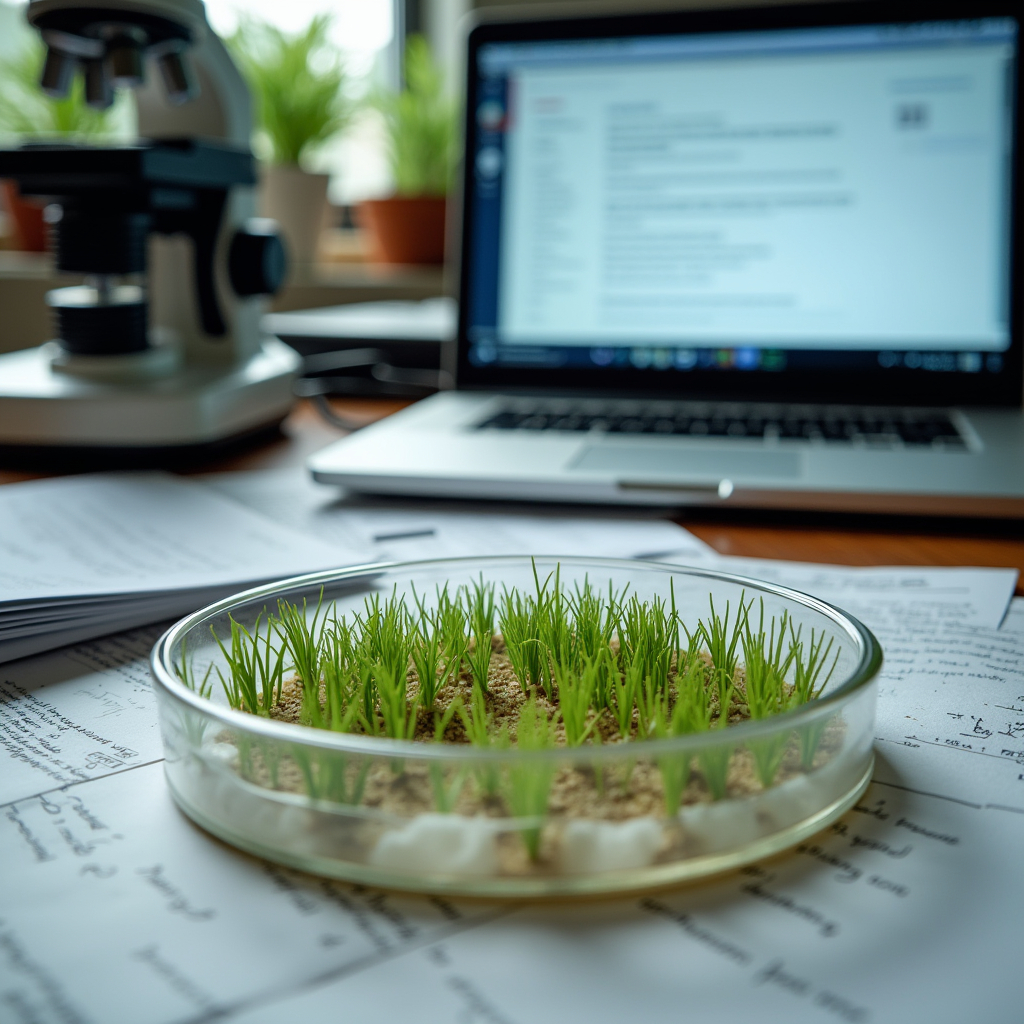This article is written by Soumyadutta Shyam. It delves deep into the subject of intellectual property rights and its application in the field of agriculture. The article also discusses in detail the need for intellectual property rights in agriculture and the different forms of IPRs and their relevance in the agricultural sector. It further analyses the legislations that exist in India for plant protection along with the criticism of the same.
Table of Contents
Introduction
Like innovation and ingenuity in other fields of work is protected, innovation and ingenuity in the field of agriculture also needs to be safeguarded. Thus, the safeguard of intellectual property (IP) law has also been extended to agricultural products. Similarly, certain rights have also been bestowed upon plant breeders and farmers in respect of the new varieties of plants or cultivars they develop.
Over the last few decades, the protection of intellectual property has been expanded to a broad variety of subject matters including information, materials and commodities in respect of food and agriculture. Generally, IP laws like patents, plant breeder’s rights, preservation of plant varieties and farmer’s rights and geographical indications are deemed very important in agriculture.
The agricultural scientists are comparatively unaware of IP issues because their main focus has always been the free delivery of technology to users, particularly farmers. However, with the growth of global trade, where national governments are entering into bilateral agreements for tackling IP issues to promote trade, agricultural scientists must also look into managing their intellectual properties. Let us first discuss in detail what exactly is IP and how it is needed in the agricultural sector.
What is intellectual property
Intellectual property rights (IPR) are rights regulating the use of creations of human intellect. Patents, trademarks, copyright, industrial designs, geographical indications, plant breeder’s rights etc. are all examples of intellectual property. The aim of IPR is to prohibit third parties from exploiting safeguarded subject-matter without express permission of the proprietor for a specific term as prescribed by law.
IPR can be defined as legal rights over innovative and original ideas. Intellectual properties are the product of the human mind and are crucial in case of trade and commerce. The rationale behind the protection of intellectual property rights is to safeguard and recognise creative ideas.
Intellectual property is different from intangible property, as ownership over intellectual property only exists only for a specified period of time. In addition, there is also an ethical element in intellectual property as it involves issues like rights of the creator over their intellectual property, equitable sharing of benefits and access to knowledge. They secure the rights of the creators by recognising their mental labour as well as permitting them to maintain property rights on their creations.
IPR encourages inventions that boost the social, economic and scientific evolution of the society by motivating the innovators and permitting them to earn profits out of their innovations. It facilitates fair trade and protects the proprietary rights of the creators.
The World Intellectual Property Organisation (WIPO) and the Trade Related Aspects of Intellectual Property Rights (TRIPS) have played a crucial role in the global recognition of IPR. Now, let us discuss how IPR became relevant in the field of agriculture and whether there is any need for the same.
Need for intellectual property rights in agriculture
Initially, IP law did not apply to the agricultural sector. However, recently, the situation has changed. Now, agriculture is seen as an industry where research and development is extremely important to attract investment. Therefore, intellectual property rights have been slowly extending to agriculture as well.
Earlier patent laws did not provide protection to inventions related to plants, agricultural produce, agricultural or horticultural methods in any country. However, this changed in 1930 when a special type of patent was introduced by the Plant Patent Act, 1930 in the United States of America (US) for vegetatively propagated materials. Before 1970, patent protection to plants was generally denied because of non-conformity of plant invention with the statutory requisites of patentability.
One of the main arguments against patenting plant breeder’s products, including those that were artificially modified, was that it was not the outcome of an inventive process. They lacked creativity, that is the chief requirement for granting patents and therefore, they were not deemed as inventions. They were considered products of nature with minor human intervention. Besides, IPR protection for agricultural products was also stalled as it was believed that agricultural products lacked industrial applicability.

By the first half of the 20th century, agriculture in the US and Europe became commercially less significant. Thus, governments reduced their contribution to the development of agriculture and stopped distributing seeds to the cultivators. This resulted in the growth of private seed industries. This growth was diminished by the characteristic of seeds that could be reused for many generations of cultivators, once bought. This opportunity resulted in the initiation of legal safeguard for plant varieties.
Novel varieties of plants are grown after many years of selective inheritance of traits that produce improved yields, better quality and increased resistance of such plant varieties. This led to an increase in agricultural productivity in various regions of the world.
As the procedure of plant breeding is lengthy and costly, it is impossible to have continued breeding endeavours until there is an opportunity for incentive for the investment in time and labour. This necessitated legal protection for plant breeding and innovation in the agricultural sector.
The importance of geographical indication (GI) for agricultural products can be understood from the fact that many agricultural products like certain varieties of teas, oranges, bananas, rice, wheat, coffee etc. are associated with the region in which they are grown. In a competitive agricultural food market, GI-label can ensure more local, genuine and high quality food products. This also gives farmers a chance to market their products and earn more profits. Geographical indication for agricultural products also has the potential to boost the local economy.
There are various types of intellectual property rights that can be utilised to safeguard intellectual property in the agricultural sector. They are as follows:
- Plant breeder and farmers rights,
- Geographical indication,
- Trademarks on agricultural products,
- Trade secrets of agricultural products,
- Rights of biological diversity.
Among these many types of intellectual properties, different aspects of agriculture are protected. Let us briefly discuss the international IP laws protecting agricultural products at a global level before diving into each IPR and their relevance in detail.
Protection of plant varieties under international law
The safeguarding of the rights of plant breeders together with farmers has obtained recognition in several countries. These countries have realised the significance of providing protection to new variation of plants not just for the advancement of agriculture in their nation as also for safeguarding the interests of plant breeders.
The word breeder has been defined under Section 2(c) of the Protection of Plant Breeders’ and Farmers’ Right Act, 2001 as a person, group of persons, farmers or any institution who have bred, evolved or developed any variety of plant. Plant breeders’ rights are rights bestowed on them in the form of sole authority on the propagating materials e.g., seeds, cuttings, divisions, tissue culture as well as harvested materials e.g., cut flowers, fruit, foliage etc. of a new variety for a fixed duration.
They are aware of the issues that might arise as a result of the recognition of the rights of breeders and especially of the restrictions that the needs of the public welfare can have on the implementation of this kind of right. They consider it very important that such issues should be resolved according to clearly defined principles.
Trade Related Aspects of Intellectual Property Rights (TRIPS)
TRIPS, as previously stated, mostly deals with the industrial intellectual properties. In this, it also briefly covers plants and animals as a subject of patent protection. Sub-paragraph (b) of paragraph 3 of Article 27 in Section 5 (Patents) in Part II of the TRIPS agreement mentions the provision in relation to safeguarding of plant varieties, which reads as follows:
“3. Members may also exclude from patentability:
(b) plants and animals other than micro-organisms and essentially biological processes for the protection of plants and animals other than non-biological and microbiological processes. However, Members shall provide for the protection of plant varieties either by patents or by an effective sui generis system or by any combination thereof. The provisions of this paragraph shall be reviewed four years after the date of entry into force of the WTO Agreement.“
Therefore, based on this provision, the members of the World Trademark Organisation (WTO) have to take steps for safeguarding the rights of plant breeders and farmers, as also to fuel the propagation of novel species of plants.
UPOV International Convention for the Protection of New Varieties of Plants, 1991
Another international legislation that promotes Ip protection for plants varieties is the UPOV International Convention for the Protection of New Varieties of Plants, 1991 (hereinafter referred to as ‘UPOV Convention’), which was drafted by the International Union for the Protection of New Varieties of Plants (UPOV). It has also played an important role in protecting plant breeders’ rights to save, use and exchange seeds.

The basic purpose of this convention is to provide an efficient system for plant variety protection. At present 76 nations are members of the UPOV Convention. The main objective of this convention is to recognise and to ensure to the breeder of a new plant variety or to their successor rights over the said variety, which it successfully does so.
Article 4 provides that citizens of a member nation and legal entities having their registered offices within the territory of a member nation shall, in relation to the grant and protection of the breeders’ rights within the territory of another member nation enjoy the same treatment as is accorded or may hereafter be accorded by the laws of each such other member nation to its own citizens or legal entities. They shall abide by the conditions and formalities in respect of breeders’ right enforced on the citizens of the said other member nation.
Article 5 lays down that the breeders’ right shall be granted only when the variety is new, distinct, uniform and stable. The grant of the breeders’ right shall not be dependent upon any additional conditions provided that the variety is designated as a denomination in accordance with the provisions of Article 20.
The applicant must comply with the formalities provided for by the law of the contracting party with whose authority the application has been submitted and the requisite fees has been paid.
Article 14 bestows the following rights on a breeder in respect of the propagating material of the protected variety:
- Production or reproduction,
- Conditioning for the purpose of propagation,
- Offering for sale,
- Selling or other marketing,
- Exporting,
- Importing,
- Stocking for any of the above for any of the above purposes.
Based on these international laws and treaties, most of the IP laws in India have developed to what we see them as today, especially the IPR relating to plant varieties and other agricultural commodities.
Legislations for plant protection in India
The prompt for the commencement of the plant variety protection scheme in India was the duty laid down on all member countries of the WTO, particularly in Article 27.3(b) of the TRIPS agreement for some sort of protection for intellectual property in case of plant varieties.
Plant variety property (PVP) was also considered important from the standpoint of commercial breeders, farmers and furtherance of food security. This led to the enactment of the Protection of Plant Varieties and Farmers’ Rights Act, 2001, which we will discuss further in the article along with the other legislations that protect agricultural goods and commodities in India.
Protection of Plant Varieties and Farmers’ Rights Act, 2001
This Act acknowledges the contributions of both commercial plant breeders and farmers in plant breeding activity and seeks to implement the TRIPS agreement in a way that favours the socio-economic interests of all stakeholders including private sector, public sector, research institutions and farmers. Let us discuss further about the objectives behind the implementation along with the rights established in this legislation.
Objectives of Protection of Plant Varieties and Farmers’ Right Act, 2001
The Protection of Plant Varieties and Farmers’ Right Act, 2001 was enacted with the following aims:
- To provide for the institution of an efficient scheme for safeguarding of plant varieties, the legal rights of farmers and plant breeders as well as to boost the development of new varieties of plants;
- To safeguard the rights of the farmers in relation to their contribution made towards the conservation, improvement and providing plant genetic resources for the development of new plant varieties;
- To safeguard plant breeders’ rights to seek funding for research and development, both from the public as well as private sector, for the development of new plant varieties to attain increased agricultural growth in the nation;
- To aid the growth of the seed industry in the nation that will confirm the supply of good quality seeds and planting resources to the farmers;
- To ensure compliance with Article 27(3)(b) of the TRIPS agreement and to take necessary measures for safeguarding the rights of plant breeders and farmers.

Rights under Protection of Plant Varieties and Farmers’ Right Act, 2001
Plant breeders’ rights
According to Section 28(1) of the Act, a breeder of a registered plant variety has the exclusive right to produce, sell, market, distribute, import or export the variety. A breeder also has the prerogative to authorise any person to produce, sell, market or otherwise deal with the variety registered under this Act.
Farmers’ rights
Section 39 bestows certain rights on the farmers who breed new varieties of plants. They are as follows:
- A farmer who has bred or developed a new variety will be eligible for registration and other safeguards in a similar mode as a breeder of a variety under this Act;
- The farmer’s variety will be eligible for registration if the application includes declarations as mentioned in Section 18(1)(h) of the Act;
- A farmer who is involved in the preservation of land races and wild varieties of crop plants and their development by selection will be eligible in the stipulated form for accreditation and incentives from the gene fund;
- A farmer will be considered to be qualified to preserve, use, sow, exchange, share or sell his farm products as well as the seed of a variation safeguarded in this Act in a similar way before this Act became effective.
Researchers’ Right
Section 30 confers on researchers’ the right to conduct any experiment or research on any plant variety. The researchers’ also have the right to use a plant variety as an initial source for developing or creating another new variety.
Other important provisions
For statutory authority
Section 3 of the Act, provides for the institution of a body termed as the Protection of Plant Varieties and Farmers’ Rights Authority. It will consist of a chairperson and fifteen members. The chairperson must have expertise in the subject of plant varietal research or in the affiliated subject of agricultural research or agricultural development.
Meanwhile, Section 8 provides for the general functions that the authority will perform. The authority will be obligated to foster steps that it deems appropriate for the upliftment and propagation of novel varieties of plants and safeguard the rights of the farmers and breeders. As per this Section, the authority shall also take steps for:
- The registration of extant and new plant varieties conditional upon such provisions and stipulations and in the way as may be directed;
- Developing characteristics and documentation of the plant varieties;
- Establishing mandatory cataloguing centres for all variation of plants, seeds and germplasm;
- Making sure that seeds of the varieties registered in accordance with this Act are obtainable for the farmers and stipulating mandatory licensing of those species if the breeder of such species or any other person having the right to develop that species in conformance with this Act does not provide for production and trade in the mode as stipulated;
- Gathering statistics in relation to plant varieties, seeds and germplasm for collection and publication;
- Making sure that the register is maintained.
Application for registration
Section 16 of the Act states the persons who can make an application for registration. It can be presented by:
- A person asserting to be the breeder of the variety;
- An heir of the breeder of the variety;
- A person designated by the breeder of the variety in relation to the right to make such application;
- A farmer or collection of farmers or community of farmers asserting to be the breeder of the variety;
- A person approved in the stipulated form mentioned in clauses (a) to (d) of this Section to prefer application on his behalf;
- A university or publicly financed agricultural institute asserting to be the breeder of the variety.
The application can be presented by any person either individually or jointly. Meanwhile, Section 14 lays down that a person designated in Section 16 can forward an application to the registrar for the registration of:
- A plant variety that is of such genera and species as described in subsection (2) of Section 29;
- A plant variety which is an extant variety as per Section 2(j) of the Act;
- A plant variety which is a farmer’s variety as per Section 2(l) of the Act.
The registerable varieties of plants are covered under Section 15, which provides the terms for registration of a new variation. In order for a novel variety to be registered in conformance with this Act, it must be novel, distinct, uniform and stable. As per this Section, a new variety shall be considered to be:
- Novel, if at the time of filing the application for registration for protection, the propagating or harvested material of such variety has not been sold or otherwise disposed of by or with the consent of its breeder or his successor for the purpose of use of such variety in India, earlier than one year, outside India. In case of trees or vines earlier than six years or in other cases, earlier than four years, before the date of filing such application.

However, a trial of a new variety which has been sold or otherwise disposed of shall not affect the right to protection. Further, the fact that on the date of filing the application for registration the propagating or harvesting material of such variety has become a matter of common knowledge other than through the aforesaid method shall not affect the criteria of novelty of such variety.
- Distinct, if it is evidently distinguishable by at least one important characteristic from any other variety whose existence is a matter of common knowledge in any country at the time of submitting the application.
- Uniform, if subject to the variation that may be expected from the specific features of its propagation it is adequately uniform in its essential characteristics.
- Stable, if its essential features remain unaltered after continued propagation or in case of a specific cycle of propagation at the end of each such cycle.
Gene fund
Section 45 provides for the institution of the National Gene Fund. In the fund there shall be credited:
- The benefit sharing accepted in the recommended method from the breeder of a variety or a derived species registered in accordance with this Act, or growing material of that variety or derived species, as it may be;
- The yearly fee to be paid to the authority through royalty in conformance with Section 35(1);
- The remuneration credited in the gene fund as per Section 41(4);
- The contribution from a national and international organisation and other sources.
The gene fund will in the recommended form be applied for meeting:
- A sum payable through benefit sharing as per Section 26(5);
- The reimbursement to be paid as per Section 41(3);
- The expense for aiding the preservation and maintainable use of genetic assets including ‘in situ’ and ‘ex-situ’ reserves and for reinforcing the ability of the Panchayat in achieving such preservation as also sustainable utilisation;
- The expense of the scheme regarding benefit sharing formulated as per Section 46.
Power of authority to make order for compulsory licence in certain circumstances
Section 47 states that after the expiry of three years from the date of issue of a certificate of registration of a variety, any person interested may make an application to the authority asserting that the reasonable requirements of the public for seeds have not been complied with or not available at a reasonable price and request for the grant of a compulsory licence to undertake production, distribution and sale of the seeds or other propagating material of such authority.
Infringement
Section 64 deals with violation of the right of the breeder. It states that a person who is not the actual breeder of the cultivar or a licensee of that cultivar if trades, imports or produces such species, will commit a violation of the rights of the breeder.
Penalties
Section 70 states that the punishment for making use of false denomination to a variety registered in accordance with the enactment will be imprisoned for a period that will not less than less than 3 months but may extend to 2 years or with fine that will not be less than 50,000/- rupees but can extend to 5,00,000/- rupees or both.
Meanwhile, Section 71 provides the punishment for trading variety with deceptive denomination will be imprisonment for not less than 6 months and may extend up to 2 years or with fine that will not be less than 50,000/- rupees but can extend to 5,00,000/- rupees or both.
Biological Diversity Act, 2002
The word “biological diversity” is generally used to describe the number and variety of living organisms on the planet. Biological resources need to be used sustainably and responsibly. Recently, IPR protection has been afforded to biological diversity.
The crucial effect of IPR, particularly patents, on biodiversity is that the rights of nations on their genetic assets gives rise to direct or indirect misappropriation of biological or genetic assets, specifically, the traditional knowledge, that has been termed ‘biopiracy’. However, if the biodiversity of an area is not safeguarded, it can also result in adverse effects, specifically in the sector of agro-biodiversity. This can include displacement of indigenous or traditional crops.

The utilisation and economic application of genetic resources has given rise to financial gains to both the developing and developed nations. But, when enjoying the gains, it is vital to decisively regulate the application of IPR on biological and genetic resources as advancement is dependent upon the same. Thus, it is also significant to efficiently share the gains among the users and providers of these biological assets.
In India, the Biological Diversity Act, 2002 brought in to protect the biological diversity of India, which included both plants and animals. In the context of agriculture, this Act allows benefit sharing of different biological resources including different varieties of seeds and plants while also protecting the plant varieties of India from being stolen abroad and monopolised at the cost of the farmers and plant breeders.
Let us dive further into this legislation by discussing its objectives and the rights given to the researchers and farmers.
Objectives of the Biological Diversity Act, 2002

The Biological Diversity Act, 2002 was enacted by the Indian Parliament with the following objectives:
- To regulate access to biological resources of the nation with the aim of securing equitable share in benefits arising out of the use of these resources and awareness relating to biological resources. This includes plants that may be used in agriculture as well.
- To preserve and sustainably utilise biodiversity.
- To respect and safeguard knowledge of local communities.
- To ensure sharing of benefits with local people as preservers of biological resources and holders of knowledge relating to the utilisation of these resources, which may or may not include traditional methods and techniques of agriculture.
- To preserve and develop the areas of significance from the perspective of biological diversity by proclaiming them as biodiversity heritage areas.
- To safeguard and rehabilitate the endangered species.
- To involve the institutions of self-government in the scheme of enforcement of this Act through the institution of committees.
Rights under the Biological Diversity Act, 2002
Researchers’ rights
Section 5 states that if collaborative research projects are approved by the Central Government and are formulated in accordance with the policy guidelines prescribed by the Central Government, they are exempted from the provisions Section 3 and 4.
In other terms, it means that they can undertake biodiversity related research and transfer the results of the research and transfer the results of the research related to biological resources occuring or acquired without the approval of National Biodiversity Authority (NBA). These biological resources can include agricultural plants or products and the research on them to determine the results produced from different plant varieties.
Rights of local communities
The Act also gives importance to the rights of local communities over biological resources. This is especially for the communities that have been using the said biological resources for generations and have gathered traditional knowledge regarding the same.
Section 21(3) of the Act states that when a biological resource or knowledge was a result of access from a specific individual or group of individuals or organisations, the NBA may direct the amount, which may be paid by way of benefit sharing, to be paid to such individuals or organisation as per the terms of any agreement and such manner as it deems fit.
This benefit sharing can include the information regarding the plants, how they are grown and maintained as well as their usage.
Other important provisions
National Biodiversity Authority
Section 8 provides for the establishment of the National Biodiversity Authority (NBA) by the Central Government to regulate the use and transfer of biodiversity resources at the national level. The NBA shall comprise of a chairperson, eight ex officio members and five non-official members.
Meanwhile, Section 18 of the Act mentions the functions of the National Biodiversity Authority which are given as follows:
- To regulate the activities relating to access to biological diversity, permissions in respect of transfer of results of biological research occurring or acquired from India, application for intellectual property for invention based research or information on a biological resource and to issue guidelines for access to biological resources and for fair and equitable benefit sharing.
- The authority is also competent to grant permissions to making applications for patents connected with biological research in foreign countries.
- The authority may advise the Central Government on issues relating to preservation of biodiversity, sustainable use of its components and equitable sharing of benefits arising out of use of Biological resources.
- To advise the State Government on selection of areas of biological diversity.
- To oppose the grant of intellectual property rights on any biological resources acquired from India in any other country. This includes patenting any method of agriculture used in India or even registering or using any plant variety commonly found in India without permission of the authority or the Central Government.
Central Government to prepare strategies and plans for the conservation

Section 36 states that the Central Government shall develop strategies, plans and programmes for the preservation and sustainable use of biological diversity including steps for identification and observe areas rich in biological areas resources, promotion of in situ and ex situ conservation of biological resources, incentives for research, training and public education to increase awareness with respect to biodiversity.
They also have the responsibility to integrate the preservation and sustainable use of biological diversity into relevant sectoral or cross-sectoral plans, programmes and policies. The Central Government can also use research in agro-biodiversity to plan strategies for boosting agricultural productivity, including introduction for more efficient and scientific methods of agriculture, modified plant varieties, efficient pesticides and herbicides, etc.
Geographical Indication of Goods (Registration and Protection) Act, 1999
Geographical indication (GI) denotes an indication or sign that identifies such goods as agricultural commodities, natural commodities as produced in a specific geographical location. Geographical indications are marks connected with commodities originating from a particular country, region or locality where the characteristics of the product are mainly ascribable to its geographical origin.
Many geographical indications relate to agricultural commodities. Some famous examples are Darjeeling tea and Basmati rice. These agricultural products are produced using traditional knowledge and are connected with a specific region and can be protected as GI. In case of GI, commercial benefits can be accrued only when the name of a place becomes connected with an agricultural commodity.
Basmati rice, a unique cultivar of rice, is cultivated in the lower reaches of Himalayas. The matter became disputable when it was realised that an US company has discovered the molecules that give the signature aroma to the rice. Therefore, basmati rice was farmed in the US in green houses. The specific seed produced by biotechnology was patented in the US.
The Indian Government raised the issue with the US Patent Office and was able to prevent the patenting of a geographical indication. The US Government also supported India on the Basmati rice issue.
However, India could not get assistance from WTO on the matter of infringement of geographical indications law in respect of patenting of a geographical indication name. The cause for this was, India did not have its own law for registration of geographical indications, thus, WTO was of no assistance.
Therefore, Geographical Indications of Goods (Regulation and Protection) Act, 1999 (hereinafter referred as the ‘GI’ Act) was enacted in India with the aim to safeguard GI in respect of agricultural commodities, natural commodities or manufactured commodities originating in a particular country, region or locality.
In India, Darjeeling tea is registered as a GI under this Act, along with many other agricultural products like Nagpuri oranges, hathei chilli from Manipur, Gobindobhog rice from West Bengal, etc. As per Agricultural and Processed Food Products Export Development Authority (APEDA), India has 229 registered food and agricultural GIs up to the year 2024.
Protection provided to agricultural commodities
Since agricultural commodities can also be registered as GI, the provisions of this Act are equally applicable to the agricultural goods. Some these provisions are discussed as follows:
Definitions
Section 2(1)(e) states that ‘geographical indication’ in regards to goods, denotes an indication which identifies such goods as agricultural goods, natural goods or manufactured goods as originating, or manufactured in the territory of a country, or a region or locality in that territory.
The quality, reputation or other characteristic of such goods is essentially attributable to its geographical origin and in cases where such goods are manufactured goods one of the activities of either the production or of processing or preparing of the goods concerned takes place in such territory, region or locality, as the case may be.
Meanwhile, Section 2(1)(f) states the definition of ‘goods’, which refers to any agricultural, natural or manufactured goods or any goods of handicraft or of industry and includes food stuff.
Producer
Section 2(1)(k) states that ‘producer’ in respect of goods means any person who –
- If such goods are agricultural goods, produces the goods and includes the person who processes or packages such goods;
- If such goods are natural goods, exploits the goods;
- If such goods are handicraft or industrial goods, make or manufacture the goods.
It also includes any person who trades or deals in such production, exploitation, making or manufacturing, as the case may be of the goods.

Other important provisions
Registration of particular goods and area
Section 8 sets out that a geographical indication may be registered in respect of any or all of the goods, comprised in such class of goods as may be classified by the registrar and in respect of a country, or a region or locality in the territory of a country, or a region or locality in that territory, as the case may be. This includes agricultural products and food that may be dignified in the speciality of some place and have its origin in the same locality.
The classification shall conform to the international classification of goods. The registrar may publish in the stipulated manner an alphabetical index of classification of goods. Where any question arises regarding classification of goods or the determination of the definite area it shall be determined by the registrar whose decision in the matter shall be final.
Application for registration
Section 11 provides that any association of persons or producers or any organisation or authority established by or under any law for the time being in force representing the interest of the producers of the goods to file an application for registration accompanied by the prescribed fee.
The application shall contain a statement, the class of goods, the geographical map, the particulars regarding the appearance of the geographical indication and a statement containing the particulars as may be directed.
Other forms of Intellectual Property law in agriculture
Patent
A patent is a right bestowed on a person who has created a novel and useful product or an advancement of an existing product or an innovative procedure of making a product. It includes the sole right to produce the new product or manufacture a product in accordance with the invented method for a defined term. Patents can be useful to protect the intellectual property for new agricultural tools, equipment, machinery, fertilisers, pesticides etc.
Patents in India are regulated by the Patent Act, 1970. This Act has been modified thrice since 1995 in 1999, 2002 and 2005 to ensure compliance with its obligation under TRIPS. Most of the people in India depend on agriculture and related activities for a living.
The Patent Act has been strictly enforced specifically in generating different research technologies and inventions. As per the Indian Patent Act, 1970 and the subsequent Patent (Amendment) Act, 1999 and 2002 patents would be applied mostly for agricultural equipment and machinery or the methods for the development of agricultural chemicals.
Techniques in agriculture or horticulture, like plant varieties or plants to make them resistant to diseases or to boost their economic importance or that of their commodities as such did not comprise patentable subject matter under the earlier patent law.
Prior to 2004, for inventions in respect of chemical processes i.e, biochemical, biotechnological and microbiological processes and substances meant for use or capable of being used as drug or food, patent was not granted to the substance but for the process used by the manufacturer. After the Patent (Amendment) Act, 2005, inventions connected to agrochemicals have become patentable.
Trade marks
As one may already be familiar with, trade marks are marks that help the consumers of a product or service recognise its originating manufacturer as well as quality based on the said origin. The trademarks used in trade and business can also be utilised for both agricultural and industrial commodities.
For example, trade marks can be used to advertise agricultural products like seeds, seedlings, fertilisers, manure, etc. Even agricultural products like fruits and vegetables can be sold under recognised agricultural brands. Furthermore, certification marks like Agamrk also act as a certification for the quality of goods since they signify that the agricultural products have met the standards set by the government.
The key aim of a trademark is to set aside the goods and services of one enterprise from the other, prohibiting the sale or marketing of deceptive products. This kind of safeguard prevents the unauthorised use of commercial marks. In India, trade marks are regulated by the Trade Marks Act, 1999.
Trade secrets of agricultural products
Trade secret protection can be utilised by the agricultural field to safeguard information or techniques, for example, unique methods of crossbreeding to produce hybrid plant varieties.
In countries like the US, there are distinct statutory laws regarding trade secrets. As opposed to patents, protection of trade secrets is not time bound, as well as there is no duty to reveal the inventive or origin ideas to society. Although, the demerit of such safeguard is that it is lost at the point it is figured out independently by an unrelated party.
Trade secrets also have a key role in agriculture and its related branches to safeguard the development of hybrids, procedures involved in various biotechnology based commodities, special techniques related to various agricultural products, identification of special genes, etc.
Traditional Knowledge

Traditional knowledge refers to the practices, skills, knowledge and instructions that have been passed from generation to generation within a particular community. Such knowledge also includes agricultural practices, methods of water conservation, organic fertilisers and knowledge of weather patterns as well as soils.
Article 8(j) of the Convention on Biological Diversity (CBD) imposes an obligation on all member states to respect, preserve and maintain knowledge, innovation and practices of indigenous and local communities.
WIPO defines traditional knowledge as know-how, skills and practices that are developed, sustained and passed on from generation to generation within a community, often forming parts of its cultural and spiritual identity.
The Patents (Amendment) Act, 2005, was passed with the objective of safeguarding the indigenous communities. It imposes a duty on the patent applicants to reveal the origin of the biological resources involved in their inventions. If the patent is related to the knowledge available to the indigenous communities, it can be regarded as anticipated. Section 3(p) of the Patent Act also declares traditional knowledge or any invention based on it as non-patentable in nature.
The utilisation of traditional knowledge in protecting crops, storage of grains and other land based activities has existed in India for a long time. However, progress in scientific knowledge and development of practices based on use of agro-chemicals have gained popularity, substituting traditional practice, specifically in the resource endowed agricultural sector.
The Indian Council of Agricultural Research (ICAR) under National Agricultural Technology Project (NATP) has initiated a project on ‘collection, documentation and validation of indigenous technical knowledge (ITK)’ in June, 2000. The purpose of the project was to gather information about traditional practices related to agriculture and allied sectors.
At present, there is a need to collect and gather knowledge about traditional practices in agriculture as well as to provide comprehensive IPR protection to traditional knowledge and practices in agriculture.
Challenges of Intellectual Property Rights in agriculture
Just as everything in the world, the application of IPR in agriculture also faces many challenges, especially in India. The evolution of technology and its transfer has several effects on the farmers, researchers and organisations engaged in the Indian agricultural sector. Some concerns of ethics in diffusion of technology and food safety arise due to this technology development and transfer.
One of the chief concerns is if intellectual property research should be linked with agriculture, as almost 60% of the population are engaged in agricultural activities. Concerns relating to IPR in agriculture must be resolved by law makers at both the national and international level.
The heredity of genetic characteristics differs across various species, where, for instance, natural out-crossing in cross-pollinated species results in loss of genetic purity. Moreover, genetic information is only economically viable to the degree that the technological mix is also available.
Plant breeders are eager to earn benefits from their research investment. Breeders are unable to recover their investment because of the exorbitant cost of high yielding varieties (HYV), Indian farmers are hesitant to adopt these technologies. IPRs generally impose restrictions on farmers’ capacity to replant, exchange or trade these varieties of seeds. The seed industry needs to be better funded.
The aim should be to make sure that research is geared towards the requirements of poor farmers. Public sector varieties should be able to compete with private sector varieties. Further, this is a sector in which nations should contemplate using competition law to deal with the high degree of concentration of the private sector.
IPR protection may decrease the rate of diffusion of agricultural technology. The impediment diffusion is due to uncertainty, risk and lack of awareness regarding new technology. In these cases, the extent of technical complexity or novelty may also be a reason for lack of diffusion. There are also concerns about dominance of private sector companies in agriculture and allied industries. It is high time to encourage public sector investment in agricultural resources.
Creating awareness among farmers regarding their intellectual property rights over the new varieties of crops and cultivars they develop is vital. Using new technology in agriculture will be convenient only if the farmers have sufficient information about the modern technology.
During the green revolution, there was success only in a few states. It did not totally substitute traditional cropping patterns. An important issue is if farmers with small land holdings will accept HYVs.
In developing nations like India, farmers lack sufficient legal awareness. This means most farmers are unaware about the IPR protection available to agricultural resources. Therefore, educating farmers about their intellectual property rights in relation to the new cultivars developed by them is crucial.
While, IPR legislation in India should be in compliance with International treaties, it should provide special safeguards for small farmers and innovators. Having a robust law safeguarding the rights of plant breeders and farmers is crucial to ensuring food security, both at the national and international level.
Merits and demerits of IPR protection in agricultural sector

While IPR has its own challenges as it is applied in the agricultural sector, there are certain advantages and disadvantages it brings for the farmers, plant breeders and anyone working in the said sector. Let us understand these merits and demerits of the IPR protection in Indian agriculture.
Merits
IPR protection has a major role in the growth and development of the agricultural sector. So, let us see what merits helped facilitate this growth as we have witnessed:
- If sufficiently protected by IPR, progress in agricultural sciences can improve food security.
- Progress in plant breeding and biotechnology have transformed agriculture and has led to increased private sector and public sector investment in the agricultural sector.
- IPR protection aids growth and innovation in the agricultural sector.
- Geographical Indications and Trademarks help in marketing and advertising agricultural products.
- IPR protection enhances research funding for gene technology in agriculture.
Demerits
Every pro has its cons and so is the case for IPR in agriculture, which is discussed as below:
- IPR protection favours multinational companies and thus hampers equitable access to agricultural technology.
- There are concerns about the safety of Genetically Modified Organisms (GMO). There are concerns about its impact on human health and the environment.
- The creation of sterile seeds from genetically modified plants prevents farmers from re-using the seeds for future crops.
- IPR protection in the agricultural sector has led to biopiracy in some cases. Biopiracy is the misappropriation of genetic resources of farming from indigenous communities.
Conclusion
A large portion of the global population is dependent on agriculture and related activities for a living. The significance of these IPR and safeguarding innnovative ideas in agriculture has been realised both nationally and internationally. However, the contention between inadequate legal validation of farmer’s rights as well as community rights and preservation of biological variation may have adverse effects on agriculture and global food security.
To summarise, we can say that the IPR regime in India needs to improve as far as legislation and implementation of laws are concerned. The requirement at present is that policy makers should modify and amend the IPR laws in such a way that it sufficiently defends the interests of farmers, scientists and also safeguards the interests of larger sections of the society. IPR laws in agriculture should be in line with methods of improving enforcement, benefit sharing, equity and justice.
Frequently Asked Questions (FAQs)
Is there any scope of copyright in agriculture?
While recipes and formulas for herbicide or manure or even techniques of agriculture can be written down, there is no actual recognised creativity in the written portion of the same. Thus, there is no scope of copyright in agriculture.
What is WIPO?
The World Intellectual Property Organisation (WIPO) is an organisation under the United Nations (UN). The main purpose of this organisation is to foster the safeguarding of intellectual property, through cooperation among the nations and in association with international organisations. The convention founding WIPO was ratified at Stockholm on July 14, 1967. It has its headquarters in Geneva, Switzerland.
What are high yielding varieties?
High yielding varieties (HYV) seeds are of greater quality than ordinary seeds. These seeds produce a better yield than regular seeds. These seeds are usually highly productive and disease resistant.
What is the ‘propagating material’ of plants?
In respect of plants, ‘propagating material’ refers to any plant or its component or any part of it including a selected seed which is capable of regeneration into a plant.
References
- Dr. S.R Myneni; Law of Intellectual Property; Asia Law House
- 03. Role of Intellectual Property Rights in Agriculture.pdf (justagriculture.in)
- http://nbaindia.org/uploaded/Biodiversityindia/Legal/30.%20PPVFR%20Act%202001.pdf
- https://plantauthority.gov.in/sites/default/files/gbrochurenewenglish.pdf
- http://nbaindia.org/uploaded/docs/biological-diversityact-ii.pdf
- I:\IJTA\2016\No 3 (2016)\No 3 ( (serialsjournals.com)
- https://nopr.niscpr.res.in/bitstream/123456789/11571/1/JIPR%2016%282%29%20131-138.pdf
- Microsoft Word – IPR-232.doc (niscpr.res.in)
- 1548828324.pdf (hau.ac.in)
- https://icar.gov.in/sites/default/files/2024-03/Geographical-Indications-of-Plant-Species-in-ITKs-in-Agriculture.pdf
- https://www.ijresm.com/Vol.3_2020/Vol3_Iss1_January20/IJRESM_V3_I1_159.pdf
- https://www.sciencedirect.com/science/article/pii/S017221902400019X#:~:text=Some%20argue%20that%20IPR%20can%20incentivize%2
Students of Lawsikho courses regularly produce writing assignments and work on practical exercises as a part of their coursework and develop themselves in real-life practical skills.
LawSikho has created a telegram group for exchanging legal knowledge, referrals, and various opportunities. You can click on this link and join:
Follow us on Instagram and subscribe to our YouTube channel for more amazing legal content.
 Serato DJ Crack 2025Serato DJ PRO Crack
Serato DJ Crack 2025Serato DJ PRO Crack










 Allow notifications
Allow notifications


